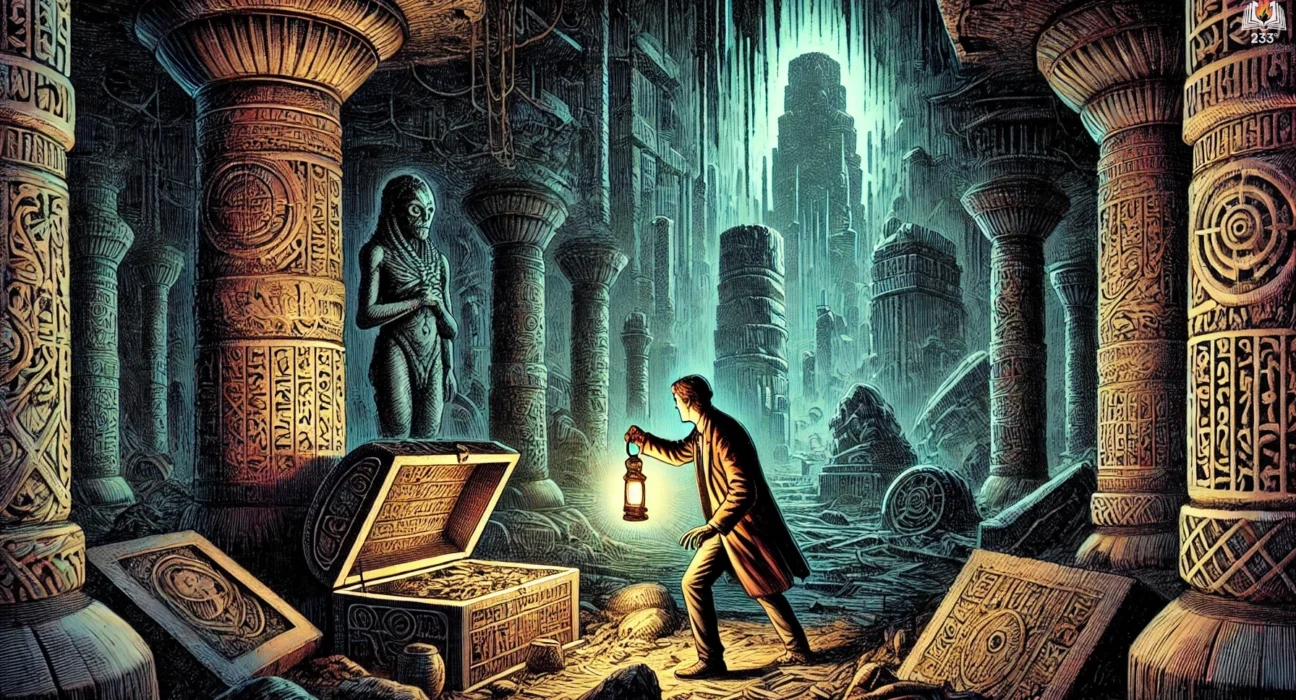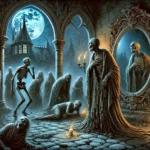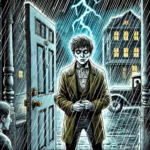The Shadow Out of Time by H.P. Lovecraft, published in 1934, is a classic tale of horror and science fiction that delves into themes of cosmic horror and the fragile nature of human sanity. This novella explores the life of Nathaniel Wingate Peaslee, a professor at Miskatonic University, who experiences a five-year period of amnesia. Upon his return to normalcy, Peaslee discovers that his consciousness may have been exchanged with an alien mind from an ancient race, leading him on a journey that questions the very fabric of time, memory, and identity.
Plot Summary
On a fateful day in 1908, Nathaniel Wingate Peaslee, a professor of political economy at Miskatonic University, experiences a sudden collapse during a lecture. Without warning, his consciousness slips away, leaving him in a deep stupor for hours. When he awakens, it is as though a different mind inhabits his body. His behavior, speech, and knowledge become alien, unfamiliar even to his closest friends and family. For five years, this strange personality dominates his life, and during that time, Peaslee embarks on peculiar travels, studies ancient texts, and behaves as if he belongs to a distant era. Though physically present, he seems mentally absent, a stranger to his loved ones. Eventually, in 1913, without explanation, the original Peaslee returns to consciousness, unaware of where he has been or what has transpired in those lost years.
Upon regaining his senses, Peaslee struggles to understand what happened. His wife divorces him, and most of his family shuns him, with the exception of his second son, Wingate. The confusion and horror of the past half-decade haunt him, but what disturbs him most are the strange dreams that begin to plague his nights. These are no ordinary dreams—they are vivid, overpowering visions of vast, ancient cities, colossal structures, and beings not of this world. The memories seem too real to dismiss as mere nightmares, and Peaslee becomes obsessed with uncovering their meaning.
As he investigates, Peaslee discovers that during his amnesia, his mind may have been swapped with that of an entity from a race known as the Great Race of Yith. The Yithians, as they are called, possess the ability to project their minds through time and space, transferring their consciousness into other beings, whether human or otherwise. In doing so, they explore different epochs, gathering knowledge from various eras and species. It becomes clear that one of these Yithians had inhabited Peaslee’s body during his years of absence, while his mind was sent far back in time to occupy the body of one of their kind.
Through fragmented memories and unsettling dreams, Peaslee realizes that he had lived in the body of a Yithian in a time hundreds of millions of years ago. In this forgotten age, the Great Race dominated the Earth, using their vast intellect to conquer time itself. Their civilization was technologically advanced, their colossal cities filled with libraries that housed the complete annals of Earth’s history, past and future. The Yithians were curious beings—massive, conical creatures with appendages capable of complex communication and manipulation of their environment. Peaslee remembers inhabiting their vast stone halls, reading ancient texts, and even interacting with other displaced minds, human and non-human, that had been captured in similar ways.
While living as a Yithian, Peaslee witnessed the wonders and horrors of their world. He roamed the endless corridors of their cities, filled with strange machinery and mind-bending technology. He saw into their libraries, where they stored records of civilizations long forgotten by humans, and he discovered the grim fate that awaited all things. The Yithians, although powerful and seemingly invincible, lived in fear of a dark, impending catastrophe—a creeping menace from the future that would one day drive them to abandon their physical bodies and flee into new forms across time. This revelation filled Peaslee with a deep sense of dread, for it suggested that no matter how advanced a civilization became, there were forces in the universe far more dangerous and unfathomable than anything they could prepare for.
Upon returning to his own body, Peaslee is consumed by a need to piece together the fragments of his experience. He embarks on a quest for knowledge, studying ancient manuscripts, obscure psychological cases, and folklore from across the world. His research confirms that throughout history, there have been rare instances of people experiencing strange amnesia, often accompanied by visions eerily similar to his own. These individuals, too, seem to have encountered the Yithians, their minds temporarily displaced by the alien race’s cosmic excursions.
Peaslee’s pursuit of the truth leads him to an archaeological expedition in Australia, where he hopes to find physical evidence of the Great Race’s existence. Accompanied by a group of scholars, he uncovers the ruins of a massive, ancient city buried beneath the desert sands—a city matching the architecture of the structures from his dreams. As they dig deeper, they discover strange artifacts and inscriptions that appear to confirm Peaslee’s theory about the Yithians’ presence on Earth. The deeper they go, however, the more Peaslee feels a growing sense of dread, as if he is awakening something best left undisturbed.
One fateful night, Peaslee ventures alone into the ruins, drawn by a mysterious compulsion. There, in the darkness of an ancient vault, he confronts the terrifying truth of his experience. He stumbles upon remnants of the Great Race, including a relic that could prove their existence beyond any doubt. But as he reaches for it, something within the ruins stirs—a lurking force, perhaps connected to the very catastrophe the Yithians feared. Overwhelmed by fear, Peaslee flees the site, leaving behind the artifact that could have confirmed his nightmarish visions. He returns to the surface, shaken and desperate to warn the others to abandon the dig.
In the aftermath, Peaslee resigns himself to the knowledge that he may never fully understand what happened to him. The dreams and fragmented memories continue to haunt him, and the fear that he may one day be reclaimed by the Yithians lingers at the edge of his consciousness. Despite his efforts to document his experience, Peaslee knows that the truth is too strange and terrifying for most to believe. He leaves his written account in the hands of his son, hoping that it may serve as a warning to future generations of the dangers lurking in the depths of time.
Main Characters
- Nathaniel Wingate Peaslee: The protagonist, a professor who experiences an unexplained amnesia that spans several years. During this period, his mind is apparently exchanged with that of an alien being from a race known as the Great Race of Yith. Peaslee’s character arc revolves around his struggle to understand the horrifying truths behind his missing years and the memories that haunt him. His pursuit of knowledge drives him into realms of cosmic horror and existential dread.
- The Great Race of Yith: An ancient, extraterrestrial civilization capable of transferring their consciousness through time. They embody the fear of the unknown and the inhuman, existing beyond the comprehension of humanity. Their minds can travel through time, occupying different bodies across eras, which forms the crux of Peaslee’s horrifying revelations.
- Wingate Peaslee: Nathaniel’s son, who plays a key role in supporting his father after his strange affliction. He becomes a professor of psychology and aids Nathaniel in his quest to unravel the mystery of his amnesia.
Theme
- Cosmic Horror and Human Insignificance: One of the core themes is Lovecraft’s concept of cosmic horror, the idea that the universe is vast and indifferent to humanity. Peaslee’s experience with the Yithians illustrates that humans are insignificant in the grand scale of time and existence. The revelation of ancient, powerful races such as the Yith undermines human notions of superiority and control.
- The Fragility of Sanity: Peaslee’s mental turmoil throughout the novella emphasizes the theme of the mind’s fragility. As he confronts the terrifying truth of his lost years and the knowledge of the Great Race, his grip on reality falters. The story suggests that human minds are ill-equipped to handle such cosmic truths.
- Time and Identity: The story challenges conventional ideas of time and personal identity. Peaslee’s experiences reveal a non-linear concept of time, where consciousness can traverse eons. This introduces a terrifying uncertainty—what does it mean to be “yourself” when your mind can be displaced or altered by forces beyond your control?
- Forbidden Knowledge: As in many of Lovecraft’s works, the pursuit of forbidden knowledge leads to doom. Peaslee’s investigations into ancient texts, strange dreams, and alien civilizations bring him closer to the truth, but at the cost of his peace of mind. Knowledge in this story is both a powerful and dangerous force.
Writing Style and Tone
H.P. Lovecraft’s writing style in The Shadow Out of Time is dense, rich with intricate descriptions and a sense of impending doom. His language is deliberately archaic and formal, reflecting the academic background of the protagonist, Nathaniel Peaslee, and reinforcing the cosmic scope of the story. The use of first-person narration immerses the reader in Peaslee’s subjective experience, filled with a growing sense of dread and paranoia. Lovecraft masterfully builds tension through detailed depictions of ancient, otherworldly settings and eerie phenomena, giving the story a slow, creeping horror.
The tone of the novella is deeply pessimistic and disquieting. Lovecraft’s signature “cosmic pessimism” permeates the narrative, as Peaslee’s discoveries about the Yithians and their manipulation of time reveal an uncaring and incomprehensible universe. The more Peaslee uncovers, the more helpless he becomes, suggesting that the pursuit of truth can lead to madness. The story’s tone is marked by an oppressive sense of fatalism, as Peaslee is ultimately left to grapple with knowledge that is both terrifying and irrevocable.
We hope this summary has sparked your interest and would appreciate you following Celsius 233 on social media:
There’s a treasure trove of other fascinating book summaries waiting for you. Check out our collection of stories that inspire, thrill, and provoke thought, just like this one by checking out the Book Shelf or the Library
Remember, while our summaries capture the essence, they can never replace the full experience of reading the book. If this summary intrigued you, consider diving into the complete story – buy the book and immerse yourself in the author’s original work.
If you want to request a book summary, click here.
When Saurabh is not working/watching football/reading books/traveling, you can reach him via Twitter/X, LinkedIn, or Threads
Restart reading!








